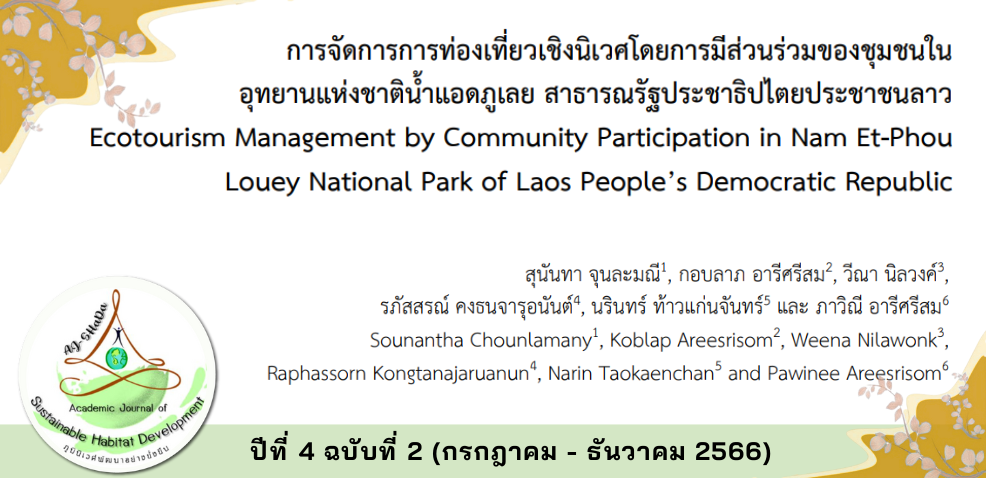Ecotourism Management by Community Participation in Nam Et-Phou Louey National Park of Laos People’s Democratic Republic
Main Article Content
Abstract
This research article aims to investigate three main aspects related to ecotourism: 1) the potential and management model of ecotourism, 2) the factors that influence the management model of ecotourism with community participation, and 3) the problems, obstacles, and suggestions for ecotourism. The research adopts both quantitative and qualitative approaches. The sample group for the study consisted of 289 individuals who resided and worked in the Nam Aet Phu Loei National Park. Data collection was conducted using a questionnaire, and the collected data were analyzed using descriptive statistics to determine percentages, means, and standard deviations. Additionally, inferential statistics were employed to conclude the data. The qualitative research component involved in-depth interviews with a group of 14 key informants. The collected qualitative data were analyzed using descriptive analysis techniques.
The study's findings revealed that the potential of ecotourism destinations in Nam Aet Phu Loei National Park, Lao People's Democratic Republic, can be enhanced through community participation. Overall, all aspects of the ecotourism management model were found to be at a high level. This model encompasses seven key aspects, namely physical characteristics, environmental quality preservation, economy and society, arts and culture, nature of the national park, safety of life and property, and providing care to enhance knowledge and awareness. Furthermore, the study identified factors that influence the ecotourism management model. It was found that these factors had a significant impact, as indicated by a Sig. F value of 0. 000 when considering the independent variables. Age, education, income, and tourism potential were identified as variables that positively influenced the model. Notably, all eight independent variables were able to predict 81. 87% of the model's variability (R2=0. 8187). However, the study also identified certain problems and obstacles in the management of ecotourism. These include transportation routes, inadequate facilities, and insufficient water supply for the communities surrounding the national park. Consequently, a water shortage problem has arisen. To address these challenges, the study recommends several guidelines for the development of ecotourism management. These guidelines include maintaining and involving the community, developing ecological resources, creating tourism activities, promoting education and training, marketing and advertising, improving transportation systems, and supporting learning and cooperation.
Article Details

This work is licensed under a Creative Commons Attribution-NonCommercial-NoDerivatives 4.0 International License.
References
ข่าวเศรษฐกิจสังคม. (2565). ข่าวเศรษฐกิจและสังคม สปป. ลาว. สืบค้นเมื่อ 30 มิถุนายน 2566. จาก http://www.sethakit-psx.la/detail10533.html
เทพรัตน์ จันทพันธ์ และวิวัฒน์ ฤทธิมา. (2556). การท่องเที่ยวโดยชุมชนของตำบลบ้านขาว อำเภอระโนด จังหวัดสงขลา. ใน การประชุมหาดใหญ่วิชาการ ครั้งที่ 4 (น.71-78). สงขลา: มหาวิทยาลัยหาดใหญ่.
พจนา สวนศรี. (2546). คู่มือการจัดการท่องเที่ยวในชุมชน. กรุงเทพฯ: โครงการท่องเที่ยวเพื่อชีวิตและธรรมชาติ.
พิมพ์ระวี โรจน์รุ่งสัตย์. (2553). การท่องเที่ยวชุมชน. กรุงเทพฯ: โอเดียนสโตย์.
สถานเอกอัครราชทูต ณ เวียงจันทน์. (2565). โอกาสการฟื้นฟูเศรษฐกิจของ สปป. ลาว จากภาคการท่องเที่ยว. สืบค้นเมื่อ 30 มิถุนายน 2566. จาก https://vientiane.thaiembassy.org/th/
Duckworth, J.W., Salter, R.E. and Khounboline, K. (1999). Wildlife in Lao PDR: 1999 Status Report. The World Conservation Union (IUCN), Wildlife Conservation Society (WCS) and Centre for Protected Areas and Watershed Management (CPAWM), Vientiane, Lao PDR.
Fennell, J. (1999). Contemporary Urban Planning. New Jersey: Prentice-Hall.
Johnson, A. (2012). A Landscape Summary for the Nam Et-Phou Louey National Protected Area, Lao PDR. Pages 73-90 in T. C. H. Sunderland, J. Sayer, and H. Minh-Ha, editors. Evidence-based conservation: lessons from the lower Mekong. Earthscan, London.
Ling, S. (1999). A biological system of prioritization for protected areas in the Lao PDR. CPAWM / Wildlife Conservation Society Cooperative Program, Department of Forestry, Ministry of Agriculture and Forestry, Vientiane, Lao PDR.
Nam Et-Phou Louey National Protected Area and Wildlife Conservation Society Laos. (2018). Ecotourism In Nam Et-Phou Louey National Protected Area, Lao PDR.
Yamane, T. (1973). Statistic: An Introductory Analysis. 2nded. New York: Harper & Row.


